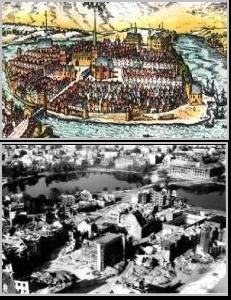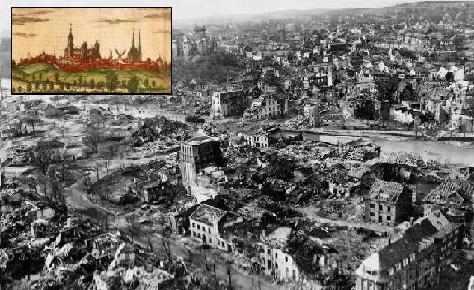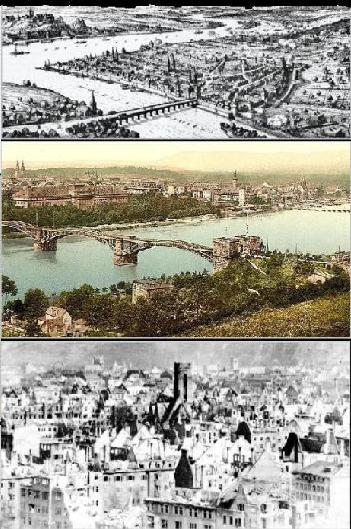

Because of its status as a naval port and submarine producer, Kiel was heavily bombed by the Allies in WW Two, destroying not only 83% of the industrial areas, but the old center city itself by 80% and the residential sector 72%. On August 17, 1944, 900 tons of bombs were dropped on the city, and ten days later another 1,448 tons of bombs. At the very tail-end of the war, on April 3, 1945, 700 bombers attacked the city again and dropped 2,200 tons of bombs on its remains. Altogether the city had 90 air raids, which destroyed 36,000 (58%)dwellings and killed 3,000 civilians. There was additionally an enormous inflow of refugees from the east, more than in any other European city, and the pre-war population grew by eight times.

The story of Percival’s son, Lohengrin, was centered here according to local legend. In 1609, the male line of Kleve became extinct, and in 1614, Kleve was aquired by Brandenburg along with Mark and Ravensberg; the Palatinate-Neuburg line of the Bavarian house of Wittelsbach took Jülich and Berg. Kleve was held by France during the French Revolutiona and in 1815 was returned to Prussia.
Although Kleve provided Henry the 8th of England one of his many wives, there was no sentimentality during World War 2 when British Bomber Command instructed 285 of its aircraft to plaster 1,384 tons of high explosive on the ancient and historic town, destroying over 90% of its medieval buildings. Nothing substantial of the medieval city remains today. Kleve claimed to be the most completely destroyed town in Germany of its size.

Philipp Christoph, elector of Trier, surrendered Ehrenbreitstein to the French, and in 1632, the town received an imperial garrison, soon overrun by the Swedes who handed the city back over to the French. In 1632, imperial forces succeeded in retaking Koblenz. In 1688, the city was again besieged by the French, but they only managed to leave a trail of fire and destruction. In 1786, Clement Wenceslaus of Saxony, elector of Trier, took up his residence and improved the city, which soon drew in French victims of religious persecution. By the congress of Vienna it was assigned to Prussia in 1822. Above: Koblenz in the 16th, 19th century and in 1945.
Especially at the end of the war, Koblenz was attacked repeatedly for no valid military or strategic reason. There were no important war industries and even during the attacks, the transportation facilities of the city were not the priority targets, the civilian population was. The heavy air raids of 1944 and 1945 of both the US and British destroyed 87% of the historic, 1,000 year-old inner city. The bombardment of Koblenz left thousands of dead and wounded and 2 million cubic meters of debris and rubble. Of the 94,417 inhabitants in 1943, only 9,000 remained in the city at the end of war, living for weeks in large concrete shelters, having lost even rudimentary necessities. She was assaulted until 1945 when the French occupied the city.
War met the small city of Krefeld on the night of June 21, 1943, when 700 RAF bombers dumped enough incendiary bombs to destroy most of the historic city center.
Since then, there was constant friction with the French. The city was rebuilt after it was burned down in 1689, and new buildings and straight roads were designed around 1700. It went from France to the Habsburgs, briefly, until it was put under Bavarian control in 1816.
The old fortress was reinforced. In 1789, the French Revolution spread into Landau, and a Liberty column and Guillotine were erected at the parade ground, renamed “place de légalité.” It went from France to the Habsburgs, briefly, until it was put under Bavarian control in 1816.
Heavy bombing by the Allies in 1944 and 1945 destroyed 40 per cent of the old town.
Thomas Nast
Landshut was almost spared destruction until the tail-end of war when, like so many others, it met needless ruination. Fortunately, most of the downtown historic district was not destroyed, but there were several attacks on the outskirts, including a severe bombing raid on March 19, 1945 which destroyed the railway station and its surrounding residential neighborhood, churches and farms.
On the night of June 5, 1940, the first air attack took place, but on the railway and factories. The city was then subjected to repeated bombing throughout the war. Finally, in August and November 1943, Leverkusen was carpet bombed. The worst attack was on October 26, 1944, when a total of 1,017 Spring loaded bombs and about 12,000 fire bombs fell, killing 124 people and causing enormous material damage. Between December 1944 and March 1945, many more lives were lost and greater destruction followed.